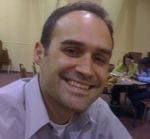 A few weeks ago librarians and researchers around the world celebrated Open Access Week. Now in its sixth year, Open Access Week is a major showcase of the benefits of making the world’s scholarship open and easy to share.
A few weeks ago librarians and researchers around the world celebrated Open Access Week. Now in its sixth year, Open Access Week is a major showcase of the benefits of making the world’s scholarship open and easy to share.
As part of OA Week San Jose State University hosted a one day un/conference on October 25. An un/conference offers a chance for structured discussions that are more informal than typical presentations. SJSU’s event combined these types of discussions with the traditional presentation format.
I was honored to lead an un/conference session in the morning and to present a formal presentation in the afternoon. This post will describe both events.
Morning un/conference session: Notes from this session are here. Participants included an instructional designer at Cal State Hayward; a librarian from San Jose State; a government documents librarian from Louisiana (!); a representative of a publishing company that is developing more affordable textbooks for students; and NCNMLG’s own Peggy Tahir.
We discussed the fact that our current system of copyright and patent law, to some extent anyway, treats ideas as commodities. We apply the same principles that govern the sale of physical items like toasters to works of the mind like novels. This may have made sense when physical publication was required to transmit an idea, but now we can distribute our insights digitally at almost no cost. As often happens, our laws and customs have not kept pace with technological possibilities. This can put librarians in the uncomfortable position of explaining the nuances of copyright law even when we know those nuances restrict the flow of information.
What’s to be done? One remedy that often applies in academic contexts is fair use, which allows for the re-use of copyrighted materials in other contexts as long as the amount of use does not cross a fuzzily defined threshold. Last year a major case at Georgia State University was broadly supportive of fair use, a positive outcome for librarians.
But even fair use is still within a framework of the economic marketplace; the litmus test is that the usage should not distort the market for a work. So we’re still treating ideas as commodities. Peggy reminded our group of the lesser known concept of transformative use, in which new uses are acceptable that significantly repurpose the original work. Now you’ve created something new and not liable for claims of copyright infringement.
The next extension of this, also suggested by Peggy, is to create your own original works when possible (such as taking pictures with a camera phone.) Now you possess the original item, and can license it via Creative Commons or some other tool that facilitates sharing. People who do this forfeit the right to sell their materials, but can be repaid in other ways….including consulting opportunities and speaking engagements that may not have materialized if their work was hard to obtain. This business model is not feasible for everyone, but at least the Web now makes such an approach possible. The best way to avoid ideas being treated as commodities is to assertively prevent this from happening.
Afternoon session: Notes from this session are here. Peggy loyally endured another hour with me, along with several librarians from San Jose State, a librarian from a school of traditional Chinese medicine in Sunnyvale, and a representative of Creative Commons.
This session began with a description of the clash between copyright laws, which restrict access to work, and the flowering of Massive Open Online Courses (MOOCs). These online courses, which sometimes contain thousands of students, assume that no barriers exist to the free flow of information. But librarians know that licensing terms restrict access to journals and other resources, because the publishers hold the copyright. MOOCs assume a utopia of information access that has yet to be achieved. Lawsuits are inevitable once publishers perceive uses of their resources that violate contracts.
What can librarians do to shift the needle toward greater openness? What types of resources will thrive in a MOOC world? The answer: it depends on your institutional context.
For very established universities (read: those with a rigid “publish or perish” culture) that wish to offer MOOCs, I recommend working to increase the liberties afforded by fair use and transformative use. Right now the reach of these concepts ends at the individual university or at most university system level. But MOOCs are global, reaching students with no university affiliation whatsoever. To legitimately license paid scholarly resources in this context will require fair and transformative use writ large. This is an area in which librarians can mobilize.
The other option is to promote and improve open educational resources (OERs), educational tools and scholarly resources which are licensed to be freely reused. This is an especially attractive option for universities that are still establishing their identities, and don’t (yet) carry the baggage of the “publish or perish” regime.
My point is not that OERs should only be used at these types of institutions. The point is that their freedom to explore how to disseminate scholarship and teaching tools can be a seedbed that eventually influences the behavior of their more established (ie, harder to change) peers.
In the long run, maximal use of OERs would be transformative for academic libraries, for education, and for the world. We shouldn’t lose sight of this goal, but in the near term we should adopt a “mixed methods” approach that harmonizes strategies with institutional culture. Going full bore for OERs at Stanford or Cal, hoping to shed that traditional publishing apparatus, is too big a leap today. But hopefully not forever.
